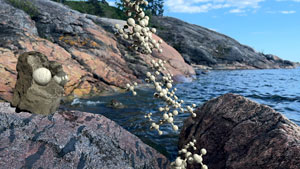RICHARD GRAYSON
W.S.I.N (Weird Shit In Nature)
Video, objects and augmented reality
2024
 |
|||
W.S.I.N. Key |
W.S.I.N. Video, 55 mins looped, Hi-Def, 5.1 Surround Sound (extracts: 6 mins) | ||
 |
|
||
 |
 |
 |
|
 |
 |
||
WSIN has three parts Objects Objects are displayed on a modular shelving and plinth system. They are made out of plaster and polystyrene and plastic and hover between models, artworks, specimens and artefacts. Some look like 20th century sculptures - abstract work informed by the natural world - biomorphic abstraction - others refer to atomic and molecular models, mathematical forms, nano-technologies, plastic waste, micro-plastics and forms from the natural and mineral world. A graphic displayed on a screen operates as a Key, identifying the forms as molecules, bacteria, elements from modernism etc. The display echoes those developed by Richard Hamilton in the 'Growth and Form', and 'Man Machine and Motion' exhibitions at the ICA and Hatton Galleries in the 1950's which had a pedagogic function and encouraged visual links, conjunctions, taxonomies, and relationships to be made across the different elements - natural/scientific/technological - on display. These set a template for how photographs of natural forms were combined with images of vaulted ceilings and images of jet planes in books and articles explaining the principles (and inevitability) of abstraction and modernist design in the 60's and 70's, locating the technological as the outcome - or improvement - of principles in nature. Video Projection The footage is of the natural world: dramatic landscapes, mountains, twisted rock formations, forests, trees caves and prairies. Here the forms first encountered on the shelves and plinths can been seen moving though these environments. They are living, coloured, moving, combining, animate entities showing intelligence and intention. The projection is large scale and there are constant shifts between animate and inanimate states; rocks walk, spinning matrixes of plastic-eating bacteria fall to the ground and shatter, there are constant shifts from micro to macro, from simple subtle individual movements to large scale flocks. Most of the footage was shot on a phone in the Pyrenees, the Alps and the Baltic. The forms/entities were generated in Blender, an open-source 3D modelling and animation software which I started learning to use over lockdowns. Exploring ways Blender could motion-track footage and link that to digital objects allowed their movement through their (new) natural environments as if in a nature Documentary. There is a dramatic and immersive 5.1 surround sound-sound environment, composed and designed by Natasha Anderson, final mix Anthony Pateras, where the viewer feels as well as hears the movements and flockings of the entities. Augmented Reality The viewer accesses a code that allows their phone camera to link to the Augmented Reality element. Through the screen they can see entities that they have watched on the video projection emerging into the gallery and world around them. Some of these entities are geo-located: only visible at certain places, others manifest themselves wherever the viewer scans the world around them through their camera lens. Augmented Reality: 10pm Studio |
W.S.I.N. Augmented Reality, Matt's Gallery, 2024 |
||
WSIN. Rationale A paper recently published in Nature said that in 2020, for the first time, the weight of Human-Made material on the planet exceeded that of the calculated bio-mass. There is now more man-made material than 'natural' material. And this material has penetrated all areas of the globe. Micro-plastics are in our blood and the high mountains, artificial substances are detected in all parts of the food chain, polythene and oil combines into new material. (source Arianne Shahvisi, London Review of Books 2021) W.S.I.N. uses digital 3D modelling and computer animation to make this world where the matter of culture/technology is seeping into the ‘natural’ world. Hybrid beings grow from plastic toys and crystals in rocky outcrops. Molecular models, smart materials and distributed intelligences leach into the mineral and natural matrixes and become new entities. These agents in W.S.I.N. might be new hybrid nature gods, components of vast structures, certain forms of ' modern sculpture' , spirits of place, monsters, mutations, art-forms, non-human intelligences, pollution, weird things that breed in the damp hollows of the internet of things. Things where boundaries between virtual and material, animate and animate, blur and shift. They are first experienced as mute physical objects, a little dusty, inert. Husks maybe. Then we see them as animate things in wilderness and mountains, their 'natural' environment. The AR technology then allows the viewer to see these forms now moving into the urban city world around them as if they have escaped into our immediate environment. The project reverses the logics of modernism, where forms were abstracted and refined from nature, to suggest that they really were making new autonomous forms. It draws on prehistories and histories of art materialising spirits and gods of mountains and caves and collides these with principles of modernist design and the Night in the Museum and Transformers and Aliens movie franchises. Ethnographer Irving Hallowell, researching animistic beliefs amongst the Objiwa people in Canada in the mid twentieth century saw that in their Anishinaabe grammar the word for stone takes suffix that indicates it is a thing it is possible to make a social relationship with. He asked an Objiwa elder if this meant that all the stones around them were alive. The elder replied ‘no... but some are’. (Handbook of Contemporary Animism ed Graham Harvey Routledge 2014) |
|||
| Matt's Gallery: Weird Shit In Nature | |||





